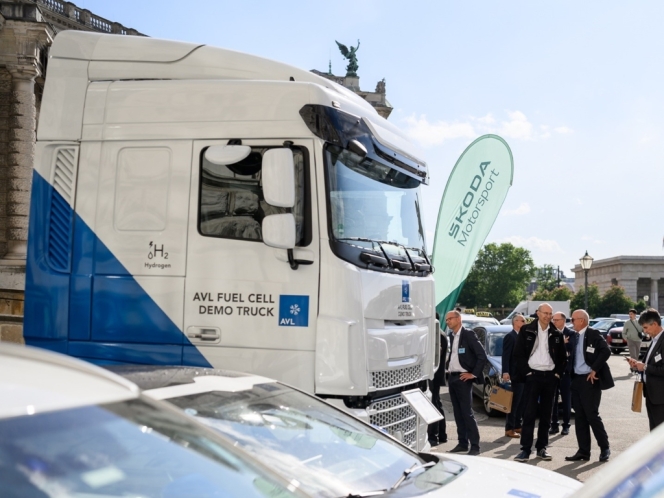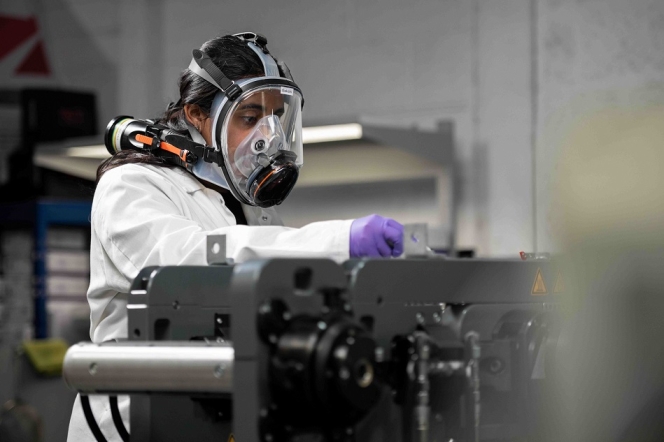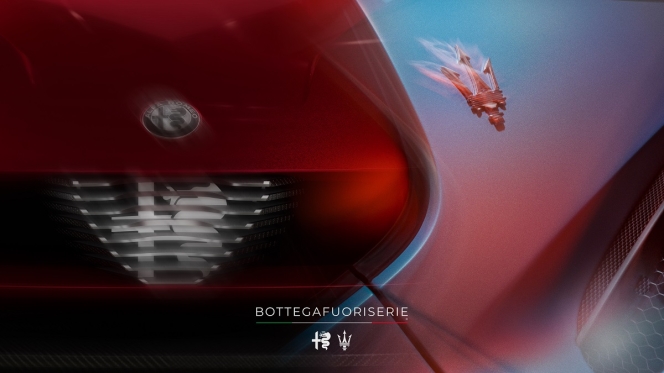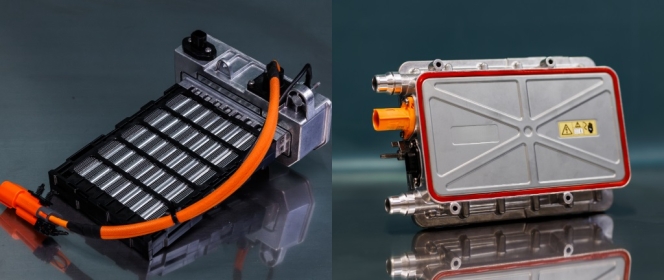- International Vienna Motor Symposium
- Prof. Bernhard Geringer
- Research Institute for Automotive Engineering and Vehicle Engines Stuttgart
- Tobias Stoll
- Frederik Zohm
- MAN Trucks & Bus
- Ego Christ
- Mosolf
- Nils-Erik Meyer
- Akkodis Germany
- Oliver Hrazadera
- Akkodis Austria
- Dorothea Liebig
- Shell Global Solutions
- Hydrogen fuel cell
- Markus Heyn
- Robert Bosch
- Bosch Mobility
- Rolf Dobereiner
- AVL List
- Christian Barba
- Daimler Truck
- Lei Liu
- Cummins
- Yuan Shen
- Zhejiang Geely Holding
- Anreas Wimmer
- Graz University of Technology
- Stefan Loser
- Christ Bitsis
- Southwest Research Institute
- Prof Bernhard Geringer
Combustion Engine Ban For CVs Proves Harder Than Expected
- By MT Bureau
- September 30, 2025

The road to decarbonisation for the commercial vehicle sector is proving to be a complex and challenging journey, with experts highlighting that a straightforward ‘combustion engine ban’ for lorries and other commercial vehicles is far more difficult to implement than for passenger cars.
Following the European Union’s strict CO2 fleet regulations for passenger vehicles, which effectively introduce a ban on combustion engines, stringent greenhouse gas limits are also being rolled out for commercial vehicles.
Experts at the International Vienna Motor Symposium stressed that the industry is racing to develop a wide array of solutions to match the huge diversity of vehicles on the road – from long-distance trucks and small delivery vans to construction and agricultural machinery.
Prof. Bernhard Geringer, Chairman of the International Vienna Motor Symposium, noted that the entire commercial vehicle industry is working on a wide range of solutions needed to match the diversity of vehicle types on the road in view of the developments expected in 2026.
The legislative pressure is intense. Tobias Stoll, a project manager at the Research Institute for Automotive Engineering and Vehicle Engines Stuttgart (FKFS), pointed out that EU legislation stipulates ‘a 45 percent reduction in CO2 emissions by 2030 compared to 2019,’ with manufacturers facing heavy financial penalties for non-compliance.
 This has set the industry's course, with Frederik Zohm (pictured above), Chief Technology Officer at MAN Trucks & Bus, expecting ‘major transformations in the commercial vehicle sector by 2030.’
This has set the industry's course, with Frederik Zohm (pictured above), Chief Technology Officer at MAN Trucks & Bus, expecting ‘major transformations in the commercial vehicle sector by 2030.’
Egon Christ, Chief Strategist at transport and logistics service provider Mosolf, commented: ‘The course has been set.’
However, the existing transport model, especially for long-haul journeys, is heavily reliant on fossil fuels. A typical diesel lorry has a service life of 1.5 million kilometres, often covering up to 200,000 kilometres annually.
Ten years ago, EU forecasts anticipated a dominant role for hydrogen and a minor one for battery-electric trucks. The reality has turned out to be ‘exactly the opposite,’ according to Nils-Erik Meyer, a division manager at Akkodis Germany.
Today, there are only around 10 fuel-cell truck models in the EU, compared to over 40 battery-electric models.
While battery-electric vehicles are currently the most technologically advanced, their widespread use hinges on a massive overhaul of charging infrastructure.
Oliver Hrazdera, site manager at Akkodis Austria, calculated: “For trucks with an electric range of 500 kilometres, the EU needs 2,000 charging points with 650 or 1,000 kilowatts of charging power.”
Batteries, payload and hydrogen’s setbacks
Freight companies prioritise fast turnarounds, which necessitates rapid charging. Dorothea Liebig, a manager at Shell Global Solutions Germany, explained that the maximum charging capacity for trucks ‘is up to eight times higher than for cars.’ She also highlighted the alternative of battery swapping, particularly prevalent in China, where it is ‘fully automated and takes just seven minutes’ at the over 1,200 existing battery replacement stations for trucks.
For many journeys, electric trucks are already viable. Meyer from Akkodis calculated that with a mandatory driver break and recharging, a truck could cover ‘around 630 kilometres are possible in one shift. This covers 90 percent of all journeys.’
However, a key disadvantage of battery-electric lorries is the impact on payload, which is reduced by ‘three to six tonnes for the drive system, mainly due to the batteries,’ according to Meyer. By contrast, hydrogen fuel cells only reduce the payload by one tonne.
Despite this advantage, enthusiasm for fuel cells has cooled in Europe. Markus Heyn, Managing Director of Robert Bosch and Chairman of Bosch Mobility, reported that in Europe and the US, a major hurdle has been the substantial cooling requirements for fuel cells, which need ‘two to two and a half times more cooling surface area than diesel trucks,’.
According to Rolf Dobereiner, product line manager at AVL List. This increased requirement consumes up to 40 kilowatts, reducing driving performance and creating challenges for achieving the high-power outputs needed for heavy-duty haulage.
An unexpected dark horse has emerged: the hydrogen combustion engine. This technology offers compelling benefits, as it doesn't require the costly, high-purity hydrogen needed for fuel cells.
Christian Barba, Senior Manager at Daimler Truck, noted that it saves costs ‘as 80 percent of the parts of a diesel engine can be reused.’
Moreover, Anton Arnberger, Senior Product Manager at AVL List, reported that it ‘is the only zero-emission technology that does not require the use of rare earths.’
The hydrogen engine ‘could achieve the torque and power of a gas or diesel engine,’ said Lei Liu, a manager at Cummins in Beijing. Cummins is testing these vehicles in India, where they are seen as a main pillar for transport decarbonisation, given the lack of a comprehensive power grid required for electric trucks.
Developers are also looking at alternatives to gaseous hydrogen. The trend in Europe is moving towards liquid hydrogen, which allows for longer ranges and is cheaper to store.
Furthermore, Yuan Shen, Chief Developer at Zhejiang Geely Holding in China, proposed methanol as ‘the best carrier of hydrogen,’ as it is a liquid fuel that is easy and safer to store and transport.
Shipping, special vehicles and hybridisation
Decarbonisation is equally challenging on the high seas. Andreas Wimmer, a professor at Graz University of Technology, reported that engines for the 100,000 ocean-going vessels in service today have a life span of over 25 years and cost hundreds of millions of euros.
By 2050, these giants must also be CO2-free. While the combustion engine will remain, fossil heavy fuel oil must be replaced by ammonia (considered an ‘up-and-comer’), methanol or limited-quantity biofuel.
The special vehicle sector – such as construction and agricultural machinery – presents one of the toughest challenges. Stefan Loser, department head at MAN Truck & Bus, noted that a forage harvester would need ‘36 tonnes of batteries to run purely on electricity,’ which is impractical. For such machines, which are used intensively for short periods, hydrogen fuel cells or combustion engines running on synthetic fuels will be essential.
Finally, in the USA, where the decarbonisation of transport is ‘less aggressive than in Europe,’ according to Chris Bitsis, head of development at the Southwest Research Institute, hybridisation (the combination of combustion engines and electric drives) is seen as a key strategy to maintain everyday usability while significantly reducing consumption and emissions.
Summing up the current situation, Prof. Bernhard Geringer concluded that battery-electric drives in commercial vehicles are currently only realistic for distances of up to 500 km and with sufficient fast-charging options. He stressed that the special vehicle sector is particularly difficult, which is where ‘hydrogen fuel cell drives or combustion engines with synthetic fuels come into play.’
BorgWarner Expands Electrification Partnership With Great Wall Motor
- By TT News
- November 11, 2025

BorgWarner is significantly expanding its partnership with Great Wall Motor by securing two new electrified propulsion projects, building upon two previously announced dual inverter programmes. These new initiatives are scheduled to enter mass production in 2026. A cornerstone of this collaboration is BorgWarner's advanced dual inverter technology, which utilises a highly integrated design. This single unit can simultaneously control and drive two motors, offering superior packaging flexibility and easier installation for vehicle manufacturers.
The technology's sophistication is underscored by its use of a power module with double-sided cooling and the latest Viper power switches. This configuration can reduce thermal resistance by as much as 50 percent compared to conventional single-sided cooling, leading to a substantial increase in power density. Furthermore, the design allows different semiconductor dies to be packaged within identically sized modules, ensuring compliance with China's stringent CLTC efficiency standards. The system also incorporates adaptive battery voltage regulation, which broadens the motor's high-efficiency operating range to improve overall performance.
Emphasising flexibility, BorgWarner employs a platform-based design that adapts to various hybrid vehicle architectures. For the newly awarded projects, the HEV version of the dual inverter integrates a DC/DC converter and offers an optional voltage boost module. In contrast, the PHEV variant is designed without these components. This modular strategy provides manufacturers with critical adaptability, enabling faster product development cycles while simultaneously reducing both design and production costs.
Dr Stefan Demmerle, Vice President of BorgWarner Inc. and President and General Manager, PowerDrive Systems, said, “BorgWarner’s technical expertise in electrification and dual inverter products has earned Great Wall Motor’s continued confidence. The extension of this collaboration not only reflects recognition of our products and technologies but also underscores our strong commitment to supporting our customers’ new energy strategies. We will remain dedicated to accelerating their electrified vehicle portfolio.”
- Anaphite
- dry coating
- wet coating
- electrode production
- carbon emissions
- electric vehicle battery
- Joe Stevenson
- Lydia Bridges
- Minviro
- Automotive Transformation Fund
- ATF
Anaphite’s Dry Coating Process Claims To Cut Battery Carbon Emissions
- By MT Bureau
- November 06, 2025

Anaphite, a UK battery technology startup, has released the results of an independent sustainability assessment of its dry coating technology platform for battery electrode manufacturing. The analysis, conducted by life cycle assessment experts Minviro, found that Anaphite's patented technology reduces carbon emissions by 3.57 kg CO2 eq. per kWh of cell capacity compared to the wet coating process.
At present, it is estimated that wet coating is used for over 99 percent of electrode production globally. It is energy-intensive due to the ovens needed to dry electrodes. Dry coating processes eliminate this drying oven.
Anaphite’s patented platform combines all ingredients of a battery electrode into a single engineered material, which is optimised for high-speed dry coating lines. The company states this approach solves the challenges of achieving dry coating at scale, unlocking carbon emissions savings for battery and EV makers.
- If Anaphite’s technology were to completely replace wet coating for every cell made in 2025, it would save 7 million tonnes of CO2.
- For a 75 kWh battery pack, the technology can deliver a 268 kg CO2 eq. saving.
With global annual demand expected to double by 2030, the adoption of dry coating is imperative to maximise environmental benefits.
Joe Stevenson, CEO, Anaphite, said, “Wet coating of electrodes is well proven, but manufacturers want it replaced by dry coating because of the carbon footprint improvements and cost reductions it delivers. Our unique dry coating process technology is the solution manufacturers need to make EVs more sustainable. We’re delighted to see its environmental benefits confirmed by Minviro’s independent assessment. We’re scaling-up the Anaphite technology platform at our facility in the UK and deepening our in-house dry coating capabilities and expertise. We are working in close collaboration with the global automotive industry to bring dry coating to market.”
Lydia Bridges, Senior Consultant, Minviro, said, “Collaborating with Anaphite on this study has been a great example of how rigorous, transparent assessment can translate innovative process design into quantifiable results. Our independent analysis identified a clear reduction in carbon footprint for Anaphite’s dry coating process compared with conventional wet coating, using ISO-aligned methods and critical review. Studies like this that follow the Environmental Footprint (EF) method provide essential environmental data for cell manufacturers, as this method forms the basis of the EU Battery Regulation carbon footprint quantification.”
The assessment is compliant with the ISO-14067 standard and the climate change model aligns with that proposed for the incoming EU Battery Passport regulations. These regulations will be mandatory from 2027 for EV and industrial batteries over 2 kWh, requiring the reporting of each battery's total carbon footprint. The work was part of a Feasibility Study project funded by a grant from the UK Government under the Automotive Transformation Fund (ATF).
- BOTTEGAFUORISERIE
- Alfa Romeo
- Maserati
- Santo Ficili
- Cristiano Fiorio
- Altagamma FOundation
- FUORISERIE
- BOTTEGA
- Corse
- La Storia
- Jean-Philippe Imparato
Alfa Romeo And Maserati Launch Bespoke Automotive Hub
- By MT Bureau
- November 06, 2025

Italian automotive majors Alfa Romeo and Maserati have joined forces to establish BOTTEGAFUORISERIE, a new automotive excellence hub in Italy's Motor Valley. This initiative aims to shape bespoke automotive experiences by merging tradition, craftsmanship and technology.
The project encompasses a broad area extending from Modena to Turin and Arese (Milan province), bringing together the legacies of both manufacturers. Cristiano Fiorio has been entrusted with the leadership of BOTTEGAFUORISERIE, reporting directly to Santo Ficili, Alfa Romeo CEO and Maserati COO. The initiative was established under the patronage of the Altagamma Foundation.
BOTTEGAFUORISERIE will focus on several main thematic areas: BOTTEGA, FUORISERIE, Corse and La Storia (History).
- BOTTEGA: This serves as the 'sartorial heart,' dedicated to developing and building 'few-off' limited edition projects, such as the Alfa Romeo 33 Stradale and the Maserati MCXtrema. This work involves collaboration with the customer to create a unique piece.
- FUORISERIE: This offers advanced personalisation, allowing customers to turn their car into a unique model. A design team will explore new creative vernaculars while remaining faithful to the brands’ aesthetic codes.
- Corse: Focused on motorsport, this theme transforms racing know-how into engineering innovation for super sports cars. Maserati Corse serves as a driving force, leveraging racing solutions to evolve the cars.
- La Storia: This initiative preserves the historical heritage of both brands through restoration and certification of vintage cars, and the creation of archives and museums, including the Alfa Romeo Museum in Arese and the Umberto Panini Maserati Collection in Modena.
Santo Ficili, CEO, Alfa Romeo and COO, Maserati, said, “This launch is more than the creation of a new initiative – it is the symbol of a new era for Alfa Romeo and Maserati. It represents our unwavering belief in the power of Italian creativity, engineering and craftsmanship. I am proud to entrust this mission to Cristiano Fiorio; his exceptional work on projects like the Alfa Romeo 33 Stradale and our motorsport programmes has demonstrated not only technical mastery but also a deep emotional connection to the soul of our brands. This is the first milestone in a broader transformation that will define the future of both Alfa Romeo and Maserati.”
Jean-Philippe Imparato, Maserati CEO, added: “We are extremely proud to announce this extraordinary joining of forces between two iconic brands. BOTTEGAFUORISERIE represents the meeting point between vision and reality. This is where dreams will be shaped into reality, where the extraordinary becomes tangible. Guided by creativity and discipline, each project is the result of rigorous research and unwavering dedication. By combining the finest in Italian design, engineering, and culture, BOTTEGAFUORISERIE embodies a unique approach to shaping the future – one we deeply believe in.”
Cristiano Fiorio, BOTTEGAFUORISERIE General Manager, said, “Being entrusted with the leadership of BOTTEGAFUORISERIE is both a profound honour and a thrilling challenge. This is somewhere where past, present and future converge – where we celebrate our heritage while daring to imagine what’s next. I will draw on the incredible experiences gained through special projects and motorsport to guide this new journey. With a team of passionate, talented individuals, we will craft vehicles that are not only technically exceptional but emotionally unforgettable. Our mission is clear: to honour the legacy of Alfa Romeo and Maserati, and to write the next chapter in their history with boldness, beauty and authenticity. Performance is an act of culture. Creating beauty is a form of art.”
Eberspaecher Expands Portfolio With 800-Volt EV Heating Solutions
- By MT Bureau
- November 06, 2025

German component supplier Eberspaecher is expanding its product portfolio with two new heating solutions for 800-volt electrical systems in battery electric vehicles (BEVs).
The company states that optimised thermal management is important for addressing challenges in electromobility, such as battery range, charging times and comfort.
Eberspaecher is introducing a coolant heater with thick film technology and an air heater with PTC technology. Both systems provide demand-based heat output for the passenger cabin and battery conditioning and can be integrated into OEM systems on a modular basis.
The new coolant heater uses thick film technology (TFE), offering a compact and powerful alternative to classic PTC technology.
- Heat Output: The component conditions the vehicle battery and achieves up to 12 kW of output at 800-volt, contributing to extending battery life and reducing charging times.
- Voltage Flexibility: The heater delivers sufficient output even at 400-volt, ensuring compatibility with the current charging infrastructure.
- Safety: The safety concept includes multiple sensors and an independently operating second shutdown path.
The thick film heater is suitable for passenger cars and trucks and has been selected by several automobile manufacturers for use in their series lines. Production is scheduled to begin in 2027.
On the other hand, the air heater, which is installed directly in the air-conditioning system, uses PTC technology.
- Multi-Zone Function: The heater features a multi-zone function allowing the driver to control the temperature separately in up to four zones in the interior, such as different temperatures for the driver and front passenger sides.
- Power Range: The heater is designed to accommodate both 400- and 800-volt architectures, with a power range of 3-8 kW.
- Emissions: Eberspaecher avoids using adhesives in the setup of heating elements wherever possible, minimising the risk of unwanted emissions in the passenger compartment.
The product will be available in Asia, Europe and North America starting in 2028.






Comments (0)
ADD COMMENT